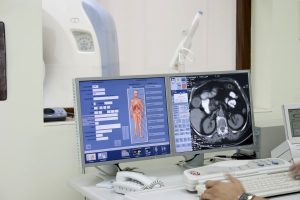There’s a day looming on the horizon where machines powered by artificial intelligence (AI) will interpret even the most complex clinical images as accurately as today’s most experienced radiologists.
 Better known as a robot radiologist, they will automatically generate final reports that are uniformly structured and with no need for preliminary reads. Their interpretation will take into account not only all of the relevant prior imaging reports but also the patients’ complete medical history. The robot radiologists will work 24/7/365 and have no falloff in diligence due to fatigue, monotony, distractions or other interruptions.
Better known as a robot radiologist, they will automatically generate final reports that are uniformly structured and with no need for preliminary reads. Their interpretation will take into account not only all of the relevant prior imaging reports but also the patients’ complete medical history. The robot radiologists will work 24/7/365 and have no falloff in diligence due to fatigue, monotony, distractions or other interruptions.
What’s more is that patients, referring physicians and federal regulators will have no less confidence in the competence of nonhuman medical diagnosticians than air travelers have today in computerized autopilots – which, by the way, already fly your plane more than 90% of the time while you are in the air.
At least, that’s the narrative on AI in radiology. Believed and circulated by a widening number of observers, enthusiasts and startup companies, this sci-fi-comes-true story seems to be gaining momentum.
However, within the medical community the thought is that a robot radiologist will augment rather than replace the profession, and that goes for as long as medical imaging itself is in existence.
Without radiologists, a hospital simply cannot function. It’s a conservative estimate that over 95% of patients who enter a hospital will have some form of medical imaging, and that as the number of patients grows, so will the demand for imaging services. As imaging becomes recognized as the crux of most diagnoses, most treatment pathways and most outcome measurements, it’s becoming apparent that there will be an almost exponential rise in demand for medical imaging, and therefore, radiologists. This is a stark counterbalance to the thought that ‘machine beats radiologist’.
A third way to look at the situation of robot radiologist vs. human radiologist is a good middle ground. Radiological practice would certainly benefit from systems that can read and interpret multiple images quickly, because the number of images has increased much faster over the last decade than the number of radiologists. Hundreds of images can be taken for one patient’s disease or injury. Imaging and radiology are expensive, and any solution that could reduce human labor, lower costs, and improve diagnostic accuracy would benefit patients and physicians alike.
Regardless of where line is, what matters right now is that AI and its offshoots, machine learning and deep learning, are already changing radiology. Research and development projects are underway, and moving at lightening speed. This activity is definitely oriented towards the future, but it’s also shaking up the present. AI attentive experts within radiology all agree on that much.
With the research and development moving along at such a high rate, it is imperative that the equipment you manufacture performs with accuracy that the medical field expects and demands. At Universe Optics we will work with your engineers to develop, design and manufacture a precision lens to meets the high standards expected within the medical community.